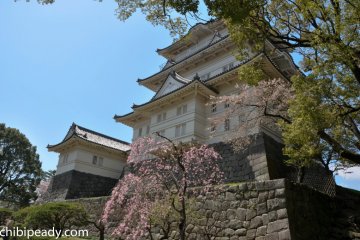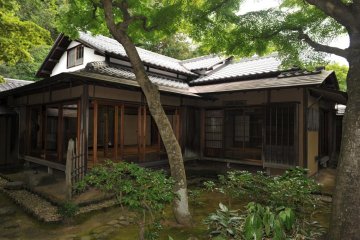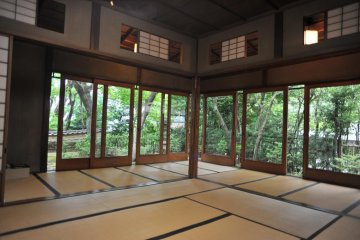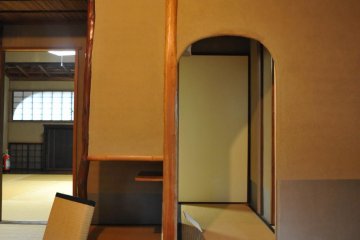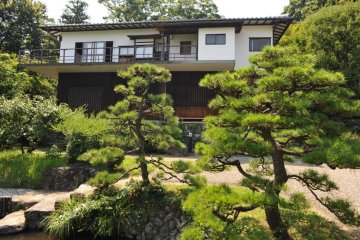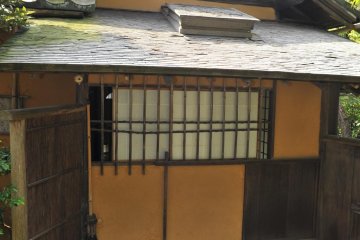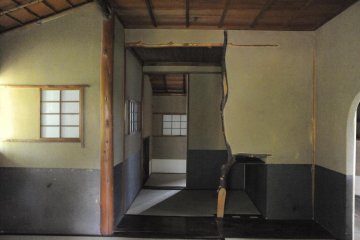The former residence of Yasuzaemon Matsunaga provides a pleasant backdrop for a short excursion in the city of Odawara. The grounds consist of a few traditional buildings as well as small gardens and a pond. It is an oasis of recent history and nature, and taking a stroll while viewing the structures reveals a glimpse of traditional architecture in twentieth century Japan.
The estate is located in the Itabashi district, and though outside the official embankments of the old castle town, Itabashi was considered to be an extension of Odawara in the Edo era (1603-1868). Many artisans lived in this district. By the Meiji era (1868-1912), it had become a popular area for wealthy Tokyo residents to own a besso (villa).
Matsunaga (1875-1971) was a businessman and entrepreneur from a young age. After leaving Fukuoka Prefecture to enroll at Keio University in Tokyo, he attended classes sporadically while pursuing several business ventures. In 1893, he joined the family business, and over the next 15 years he started or worked for several companies, including a cannery, colliery, trading company, and a stint at Japan Bank.
His big break came in 1909 when he was appointed as a vice president at Fukuhaku Electric Company, in Kyushu, which also consisted of a railway company. He later became a director at 2 other power companies in the region and eventually merged 3 of them. Kansai Electric Company was his next target, where as vice president he merged several other regional power companies together.
Finally, he became president of Toho Electric Company, in the Tokai region, and in 1922 he merged several regional power companies yet again.
All this work in the power industry gave him the nickname “electric king.” Matsunaga was an instrumental figure in the privatization of Japan’s power generation sector in the early 20th century.
However, as part of the war effort, the Japanese government nationalized the entire electricity industry in 1939. Matsunaga subsequently retired from public affairs. Ever the industrialist, he resurfaced in 1951 as a major figure in the electric industry reorganization committee that was spurred by General Headquarters, the occupying authority, that ordered the breakup of the governmental monopoly of the industry. Under Matsunaga’s leadership, a “nine-area partition plan” was drawn up and implemented, which still is in existence today.
Matsunaga appreciated the finer aspects of life as well, and he was an important art collector, and also at the age of 60, he began to study sado (the way of tea), eventually becoming one of the top three tea masters in the area at the time.
The beautiful scenery of the Itabashi area, with its views of the Hakone mountains and Sagami Bay, the warmer climate, and the posh surroundings of the governmental, business, and artisanal elite drew Matsunaga there. Whereas most others simply owned villas in the area, Matsunaga settled permanently.
To that end, on a tract of land with a small pond and a hill, he built a residence in 1946, and added to it over the years. Named Rokyoso, after the 400-year old zelkova tree in front, it is a well-preserved mid-twentieth century Japanese home built in the sukiya style (a residential architectural style that incorporates the aesthetics and architecture of sado), with a few tweaks. Matsunaga had a quirky streak and enjoyed originality, thus the mud and tile fence in front is curved and disproportionate, and the varied sizes of the tatami mats in the rooms are completely un-standard.
In Rokyoso, he sat overlooking a garden, performing the tea ceremony and hosting painters, architects, tea masters, scholars, and politicians, listening and advising even in retirement.
In 1959, a facility to house his art collection was completed. The honkantenjishitsu (main building for exhibition) was open to the public in its day. After Matsunaga passed away, the city of Odawara declined his collection, so that is held at a museum in Fukuoka. The facility now houses various historical objects in the possession of Odawara.
There are also two dedicated facilities for tea on the grounds.
The better one is named Youuan. This structure was built in 1924 by Kotaro Nozaki, a central figure in political and business circles. It was moved from the Minami-cho district to the Matsunaga estate in 1986. Built in the sukiya style, it is a teahouse in the true sense of the word, strictly conforming to specific standards while also incorporating unique aesthetics in form to make it distinct. This is truly the gem here.
The other structure, Uyakuan, was built in 1991, and while it can be used for tea ceremonies, the docent described it thus: “tea can be served here, however, it is not a teahouse.” It is a more modern structure not built to traditional specifications (witness the electrical outlets).
Entry to the estate is free. The teahouses can be viewed from the outside only, unless they are rented for tea ceremonies. Entry into the residence is free, and tea ceremonies can also be held there. Tea ceremonies range from 3-7 hours, for 1,000-3,000 yen, depending on the room and time. Reservations need to be made in advance, in Japanese.
The museum and annex gallery require a fee (500-800 yen).
Also, of special note is that Youuan and Rokyoso are registered tangible cultural properties.
The Yasuzaemon Matsunaga Estate provides a getaway between the more crowded areas of Hakone and Odawara Castle. It is a quiet sanctuary of an earlier time, perfect for strolling and taking in the sights of the grounds of an illustrious man, one who became a tea master, and where his love of sado is carried on today.




